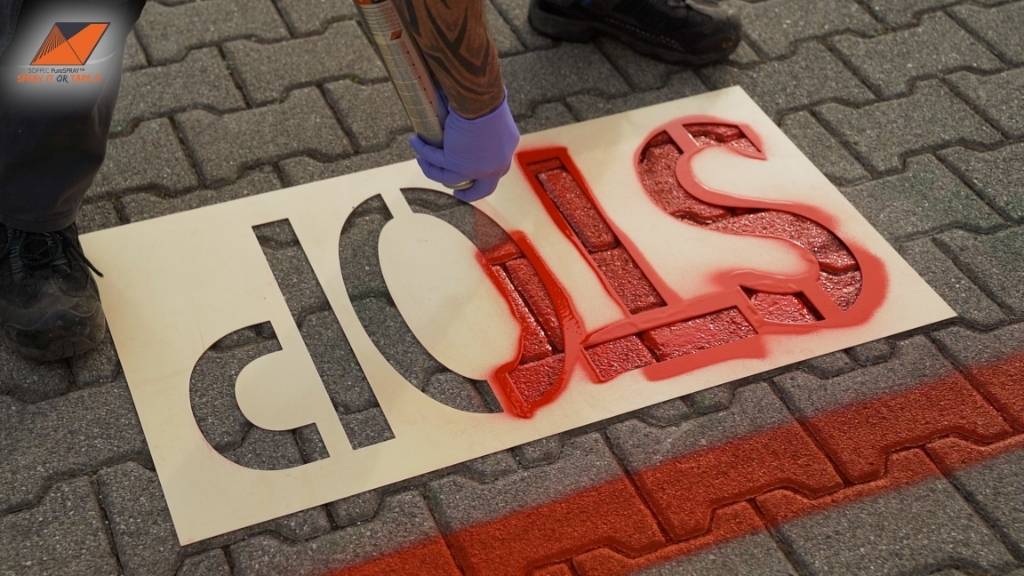SOPPEC TRACING® PRO Line Marking Paint for Fast Line Marking Work
SOPPEC TRACING® PRO line marking paint for quickly carrying out marking work
SOPPEC TRACING® PRO line marking paint is an innovative product developed to ensure workplace safety through safety markings. It allows you to carry out your markings both outdoors and indoors with high quality and exceptional durability. Especially when used in conjunction with the SOPPEC DRIVER™ line marking trolley, it is a user-friendly spray that enables marking work to be completed in the shortest possible time. Combining high environmental standards with good technical and, above all, rapid implementation of markings was Technima's goal in developing this line marking paint.
Areas of Application for SOPPEC TRACING® PRO Line Marking Paint
Precise, long-lasting, and clearly visible marking of different work areas is of great importance, especially in production facilities such as factories, workshops, or warehouses, and is particularly safety-relevant. SOPPEC TRACING® PRO line marking paint, available in white, blue, yellow, black, red, green, and gray, offers the possibility of marking different areas with different colors. In addition to its industrial use, SOPPEC TRACING® PRO line marking paint is also used for marking work in parking lots or sports facilities. SOPPEC TRACING® PRO line marking paint also provides valuable support for organizing customer routes in shopping centers, supermarkets, or government offices.
Ecological aspects of SOPPEC TRACING® PRO line marking paint
 Line marking paint is a chemical product that cannot be produced and used entirely without environmental impact. Wherever possible, Technima avoids environmentally harmful or health-hazardous substances in its paint formulations. Specifically, SOPPEC TRACING® PRO line marking paints are:
Line marking paint is a chemical product that cannot be produced and used entirely without environmental impact. Wherever possible, Technima avoids environmentally harmful or health-hazardous substances in its paint formulations. Specifically, SOPPEC TRACING® PRO line marking paints are:
- Free of CMR substances, i.e., substances with carcinogenic, mutagenic, or reprotoxic effects.
- They are produced without hexane, methanol, toluene, or xylene.
- They do not contain heavy metals such as lead or cadmium.
- SOPPEC TRACING® PRO line marking paint is based on a thermoplastic acrylic resin binder. Inorganic and organic pigments are dissolved in it. The resulting surface has a satin finish.
- The SOPPEC TRACING® PRO can does not bear any environmental hazard symbol. In particular, H-phrase 412: "toxic to aquatic organisms" does not apply.
- SOPPEC TRACING® PRO line marking paint therefore has no long-term, harmful effects on the ecosystem.
- SOPPEC TRACING® PRO line marking paint is labeled according to the applicable EU Regulation (EC No. 1272/2008).
Use of SOPPEC TRACING® PRO line marking paint in the food industry
NSF certification is required for use in food processing facilities. The National Sanitation Foundation (NSF) certifies that a product is free of PFAS. The abbreviation stands for per- and polyfluoroalkyl substances, which are also called "perishable chemicals" due to their high thermal and chemical stability. There are numerous such substances, and various studies have been conducted on their harmfulness to humans and the environment. Regulations regarding the use of PFAS vary widely around the world. Food processors who value global market access therefore insist that all non-food components used in their production have NSF certification. SOPPEC TRACING® PRO line marking paint has the corresponding certificate.
Using SOPPEC TRACING® PRO line marking paint
Before using a SOPPEC TRACING® PRO can, shake it well upside down until the mixing balls in the paint can be heard. The most common application of SOPPEC TRACING® PRO line marking paint is for applying marking lines to the floor. The spray can is therefore optimized for use in the SOPPEC DRIVER™ line marking cart. This allows lines of varying widths to be applied quickly and precisely to the floor, even directly on the wall. The cart and can are designed so that the cart does not require special cleaning after use. Different height arrangements of the spray cans in the cart determine the width of the finished line.
SOPPEC TRACING® PRO line marking paint can also be applied using a marking gun. It can also be applied by hand. Please note that SOPPEC TRACING® PRO line marking paint is designed for downward application. To empty and clean the valve, the can should be sprayed empty with the head facing up at the end of the work process until the valve is empty and only propellant gas escapes.
Increasing the Durability of SOPPEC TRACING® PRO Lines
To improve the durability of floor markings made with SOPPEC TRACING® PRO line marking paint, we recommend PROTECT LINE, a water-based protective varnish. PROTECT LINE increases the durability of floor markings made with SOPPEC TRACING® PRO line marking paint. The varnish is a water-based dispersion of acrylic resins mixed with a wax emulsion. It can be sprayed or applied with a roller or brush in one or two coats. PROTECT LINE improves the scratch resistance of floor markings and is water, stain, and dust repellent. The varnish is dry and walkable after just 15 to 20 minutes.
 Suitable Floors for SOPPEC TRACING® PRO Line Marking Paint
Suitable Floors for SOPPEC TRACING® PRO Line Marking Paint
- Concrete and other cement-based floor coverings
- Asphalt
- Gravel
- Metal
Plastic Plastic floors may be incompatible with the substances contained in SOPPEC TRACING® PRO line marking paint. Therefore, we recommend conducting a compatibility test before applying floor markings.
Accessories for applying floor markings with SOPPEC TRACING® PRO line marking paint
In addition to the SOPPEC DRIVER™ line marking cart and spray gun, there are other accessories available for applying floor markings. These include stencils for spraying clearly recognizable symbols. For example, a mask symbol, arrows, or even sole prints for waiting or walking areas.
What is the significance of colors for floor markings in production areas?
According to the German Road Traffic Act, white floor markings are used for parking spaces. However, there are also blue parking space markings, for example in Munich's old town, where a uniform parking regulation applies in the so-called "blue zones." There are also orange markings for delivery traffic. There are no regulations for private parking spaces, but white parking space markings are usually used here as well. It is important that the floor markings are clearly visible and are regularly replaced when they are no longer clearly visible.
What is the significance of colors for floor markings in production areas?
Only two colors for floor markings are regulated by the Federal Institute for Occupational Safety and Health in regulation ASR A1.3: A black-and-yellow striped marking is provided for permanent hazard areas, and a red-and-white striped marking is provided for temporary hazard areas. However, other colors have become common practice.
• White-and-green indicates first aid equipment, emergency exits, escape routes, and safety equipment.
• White indicates locations for systems, machinery, and equipment.
• Red indicates warehouses for defective goods or other restricted storage areas.
• Yellow is used for demarcated work zones as well as for driveways and footpaths.
• Finished products can be found in areas marked in green.
• Blue indicates zones where semi-finished products and materials for further processing are stored.
• Orange stands for quality control.
• Black areas are production zones.
How long does a floor marking last?
The durability of floor markings depends heavily on wear and tear. This includes not only the traffic passing over a marking, but also weather and environmental influences. Outdoor floor markings exposed to rain, snow, and UV radiation last less long than those with similar wear and tear indoors. In addition to traffic frequency, temperature and humidity are additional influencing factors. Overall, floor markings should be checked at least every two years and then repaired or replaced if necessary.
What floor marking methods are there?
A variety of very different methods are used for floor marking. In production areas, spray paints or colored adhesive tapes are commonly used. The same applies to sports halls. Spray paints are also used in road traffic, as are materials such as hot-spray plastic, cold-spray plastic, foils, or marking studs. On some sports fields, the good old gritter is still used instead of spray paint. However, these are no longer filled with lime (calcium oxide), but with chalk, i.e., calcium carbonate, since lime can cause chemical burns if athletes come into contact with it.
Does Floor Marking Tape Leave Residues?
High-quality floor marking tapes are equipped with adhesives that can be removed without leaving any residue. Cheaper versions, however, can also leave residues upon removal. However, if adhesive tapes are applied for a very long time, especially when subjected to heavy wear and tear from weather, UV radiation, or heat, residues can form even with high-quality tapes. The correct method of removal is also important and plays a role in whether this can be achieved without leaving residue. Some adhesives can be easily removed with a hairdryer, i.e., with heat, while others require special cleaning agents for adhesive residues.
Share this content
